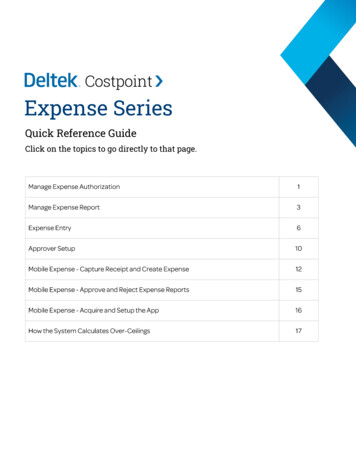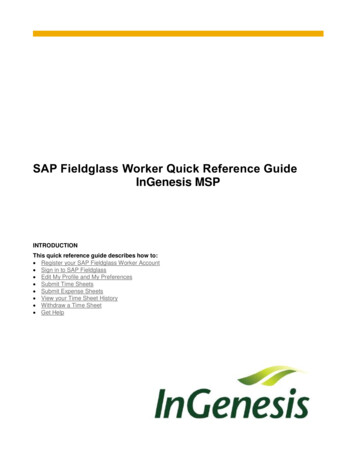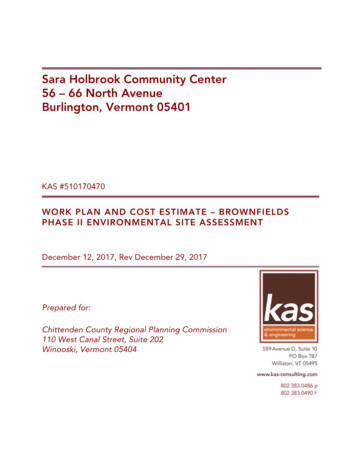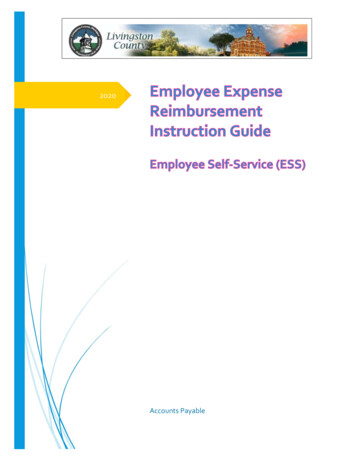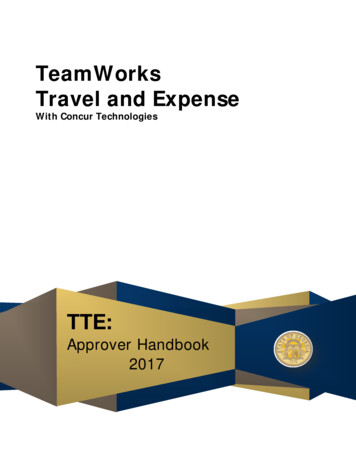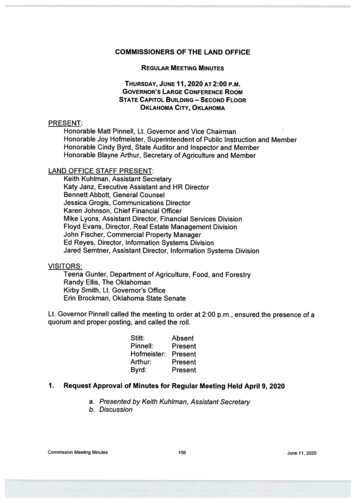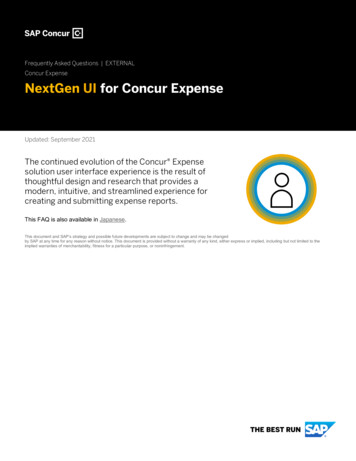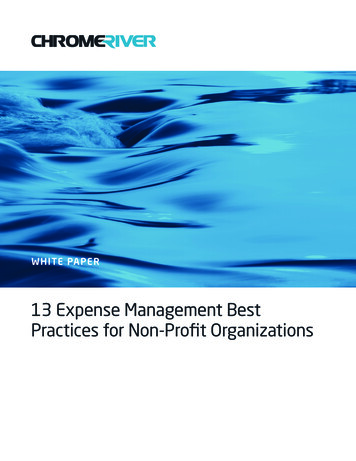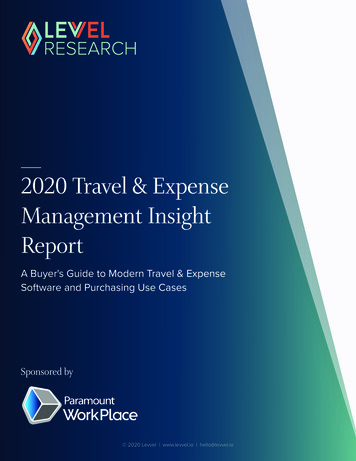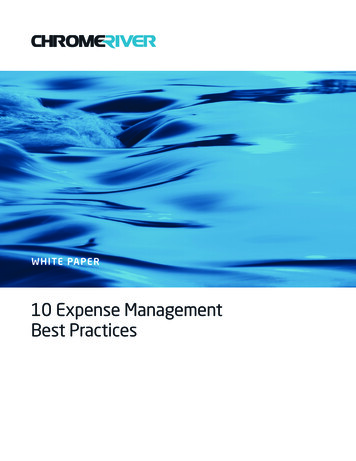
Transcription
WH I TE PAP ER10 Expense ManagementBest Practices
10 Expense Management Best PracticesOverviewWhether you are planning to write your first travel and expense (T&E) policy or you are a corporate travel veteran who hashad one in place for many years, it’s always good to look outside your own organization and see what other world-classorganizations are doing to effectively manage their employees’ spend. This enables you to refine and enhance your ownexpense management program and incorporate these best practices.However, you can’t simply hope to copy other organizations’ programs. Best practices need to be defined, implementedand enforced in order to have a successful expense management process. In particular, manual processes need to beautomated in order to reduce costs, improve accuracy, enhance consistency and increase operational efficiency.This paper discusses 10 of the most effective expense management best practices, which have been collected first-handfrom a wide range of organizations.1. Require Pre-Approvals3. Overpayment of expenses must be returned in a timelySimplicity is the key to user adoption and drives the accuracymanner. Any excess reimbursement or allowance paid to anof expense reporting. Mandating pre-approvals can greatlyemployee must be repaid to the employer within a reasonablereduce the opportunity for over-spend – either inadvertent orperiod of time.through deliberate expense abuse. Pre-approvals often workin conjunction with a corporate purchasing card, such as forIf your company fails to demonstrate that ithas an accountable plan, employee expensereimbursements may be considered astaxable income and as such, you will need toprovide them with a 1099 for those expenses.office supplies, or a travel booking system. Although employeescan browse and select their items / tickets, they can’t purchaseuntil approved by a supervisor. These systems work by alertingapprovers of a purchase request (who can change, dependenton the size of the purchase, per the organization’s policies), whomust then give their approval to make the purchase.2. Build an Accountable PlanThe trick here is that the definition of ‘reasonable period ofAccording to the IRS, to be considered having an accountabletime’ depends on the facts and circumstances of the situation.plan, your reimbursement or allowance arrangement mustHowever, actions that take place within the times specified in theinclude all of the following rules.following list will be treated as taking place within a reasonable1. The expense must have a business connection. Deductibleperiod of time.expenses must be incurred while performing services as an is incurred.employee on behalf of the employer.2. Expenses must be submitted promptly. Expenses must beadequately accounted for within a reasonable period of time.www.chromeriver.comAn advance is received within 30 days of the time an expense Expenses are adequately accounted for within 60 days afterthey are paid or incurred.
10 Expense Management Best Practices Excess reimbursements are returned within 120 days after thecard is used to make the purchase. This reduces the timeexpense is paid or incurred.employees spend creating expense reports, and the timeAn employee provides an adequate accounting of outstandingapprovers spend ensuring compliance.advances within 120 days of receiving a periodic (at least receipts. Reports show that 25 percent of expense claimsquarterly) statement.have fraudulent receipts. An example of this is a dinner bill forAs an additional requirement in developing an accountable plan, 100 that includes a 10 percent tip, but the employee turnsIRS Code Section 274(d) states that substantiation requires anin a claim for a 20 percent tip. On a corporate card, an over-employee to submit the following items with adequate records(such as receipts): Amount of the expense.Time and place of the expense.Business purpose of the expense.Business relationship of the employee to the persons receivinga gift, being entertained, or utilizing a facility or property.Given all these rules and regulations, it’s extremely importantthat organizations review their corporate travel policy andguidelines documentation with employees on a regular basis asupdates occur, or at least on an annual basis.The use of corporate cards reduces the number of falsifiedstatement of an expense like this would be caught. Carrying a corporate card eliminates the need for cash advances,which not only streamlines processes for the organization butalso eases the process for the travelers themselves.A common concern employers have about corporate cards isthat employees can incur charges on their corporate card (andtherefore company liability), then delay submitting the expensereports associated with those charges. This fear can be mitigatedby using a ‘carrot and stick’ approach that can help keepemployees motivated to submit expenses promptly.For example:Offer employees the ‘carrot’ of convenience. The corporate card is3. Initiate a Corporate Card Programa convenient tool when integrated with your T&E system. It offersIf the idea of employees carrying around corporate credit cardsa great deal of convenience to the employee by automaticallyconjures up images of reckless spending and big-ticket liabilities,downloading those expenses, taking the tedium of data entryyou should take a deep breath and possibly reconsider yourout of expense report creation.position. Today’s corporate card programs are plentiful andhighly competitive to the point where they offer numerousfinancial and operational benefits. Here are just a few of themany benefits a good corporate card program can offer: Remind employees through your expense policy—the ‘stick’—that legitimate business expenses will be paid by the companyprovided they submit timely expense claims for those charges.Reinforcing a policy that denies reimbursement of expenses forFinancial incentives and rebates for all purchases. Corporatelate submissions, regardless of whether it’s an employee liabilitycards offer a cashback rebate for all spend, which can delivercard charge or a company liability card charge, is usually plentysignificant benefits - in fact companies receive six-figureof motivation for most users.rebates on their annual corporate card purchases. Corporate cards reduce the cost of expense report handling.One industry survey on corporate card programs cited theBy integrating credit card data into T&E systems, the neednumber one benefit for implementing a corporate card programfor employees to rekey their expenses is eliminated and thewas to increase the convenience for employees. When employersaccuracy of the captured data is improved. Many companieswere asked the same question one year later, the top benefitdon’t require a receipt for anything under 75 if a corporateshifted to cost control. A properly executed corporate cardstrategy provides both benefits.
10 Expense Management Best Practices4. Automate Policy EnforcementMany organizations describe their pre-automation processas one that includes a resource intensive audit, where theaccounts payable staff manually review each expense itemto see if it is compliant with company policies. Often this taskinvolves several employees who could be adding much morevalue to the organization in other ways. By applying expensepolicy compliance rules through the use of a ‘rules engine,’all expenses are validated upfront against corporate expensepolicy, governmental policies, and even client billable policies forApproval routes can be built based on hierarchy (e.g., manager,director, VP), dollar threshold escalation, expense allocationcoding, attributes of the expense owner, and many additionalcriteria. Typical approval routing should have between two-tofour levels of approval. Too few approval levels and firms maynot be adequately reviewing their expenses. Too many, and itbecomes complex to execute and maintain. Most companiesprefer accounts payable staff serve as the final step in theapproval process before the approved voucher is exported to thefinancial system for payment.professional services organizations.With an automated process, when an employee (or theirdelegate) enters an expense that is not compliant with policy, theexpense item is immediately flagged. Depending on the type ofinfraction, the employee may be asked to provide an explanation.Approvers determine the outcome or may remove the item fromthe expense report altogether. If personal items are charged to acompany paid corporate card, expense owners can mark the itemas personal, in which case the expense is automatically deductedfrom their out-of-pocket reimbursement.It costs organizations an average of 26.63to manually process an expense report. Witha fully automated expense managementsystem that cost falls to 6.85.PayStream Advisors, 20166. End Penny-Wise-and-Pound-FoolishAudit PracticesAuditing expense reports can uncover a wide variety of issuespresented by travelers to support their expense claims. Thefollowing examples are among the top issues reported byaccounts payable professionals: Laundry expenses are submitted for trips below the durationthreshold for being a reimbursable expense. Excessive tipping.Hotel expenses (e.g. mini-bar, movies, room service) that arenot reimbursable under company policy. International expenses are reported at inflated exchange rates.Meal/entertainment participants include the expense owner’ssupervisor, who also approves the expense. Imposed per diem limits based on statutory or corporaterequirements are difficult to validate.Auditing 100 percent of expense reports is poor use of time5. Clearly Document the Approval Processand resources and gives the finance team a false sense ofsecurity. To ensure an effective auditing practice, accountsMany organizations’ expense approval processes are poorlypayable groups need to take a more methodical and calculatedrecorded and somewhat haphazard, which can lead toapproach. An important decision to make is who is performingreimbursement delays and other inefficiencies. By taking a stepthe audit: accounts payable or audit staff? Organizations needback and thinking about roles, responsibilities, and delegationto determine a statistically valid sample size for auditing andof authority, it becomes easy to build an approval matrix thatthen have auditors—not accounts payable staff—meticulouslycan be automated within an expense management solution—examine expense reports and receipts. This analysis should coverparticularly one that employs a sophisticated business rulesthe details of the current report and a three- to six-month rangeengine that can handle virtually any combination of criteria.of expenses for a specific expense owner.www.chromeriver.com
10 Expense Management Best PracticesExpense owners who fail the audit should be assigned to a riskcategory, for examples rated from 1-5. Someone who is assignedEmployees who submit expenses usinghard-copy receipts and spreadsheets aremore than twice as likely to commit fraudthan employees using automated expensemanagement solutions.risk category 5 would have all of their reports audited, whereexpense owners assigned risk category 1 would only have everytenth report sampled for an audit. Each organization needs todetermine their appropriate statistical sampling.When an audit is completed, audited expense owners shouldChrome River, 2018receive an email informing them of any issues that need to bereviewed or congratulating them on being in compliance withfirm policies and guidelines. Conducting independent audits anddiscussing the results with employees has the power to changebehavior across the organization. Good news travels fast andnews of getting your expense reports audited travels even faster!8. Centralize the Travel Expense ProcessPrior to implementing an automated expense managementsolution, most organizations describe the huge amount ofmanual intervention that is required to properly validateexpenses against company policy and ensure these expenses are7. Help Employees Make Good Decisionsrouted to the appropriate approvers prior to payment. In largeHow often do people cheat on their expense reports? While 94organizations, this can add up to considerable numbers of peoplepercent say that they submit accurate expense reports, almost sixspread across business units, regions, and offices. The bottom linepercent admit to deliberately falsifying reports, with an averageis that it costs a lot of money in organizational capital to supportannual amount of more than 2,000. One of the oft-citedthis business process, which can also create a lack of consistencyreasons for cheating is that employees feel that traveling forand process continuity. By implementing an automated expensebusiness is an inconvenience and they should receive additionalmanagement platform, a consistent, programmatic approachcompensation. Others state that there were other expenses theyreplaces a substantial amount of human intervention:forgot to enter on a prior expense report, for which they never received reimbursement, so this “evens things out.”expense entry, and employees can either be prevented fromsubmitting a non-compliant expense (‘hard stop’) or they canItems to consider to reduce expense fraud: be required to provide an explanation that will allow the ap-Require one expense report per trip so expenses are easierprover to decide if full, partial, or zero reimbursement shouldto track.be provided (‘soft stop’).Issue corporate credit cards to frequent travelers. This reduces Approval routing rules are applied based on attributes ofthe risk of the firm never receiving credit for cancelled flights,the expense items or the entire report itself (e.g. allocationas well as other types of potentially fraudulent transactions.department, cost center, project, matter, grant, amount).Implement an expense management solution that can auto-By employing a rules engine, the combinations of standardmatically identify many types of attempted expense fraud.routing and exception routes are almost unlimited yet easy toDo not allow future dated travel that is not charged to a cor-create and maintain.porate charge card. Expenses are validated against corporate policy at the time ofEstablish a policy that requires the most senior employee at ameal to pay the check. Possible duplicate expenses can be flagged at the time ofexpense entry or audited as part of analytics reporting. Approvers can now focus on ensuring that proper allocationswere provided for the expense and spend is appropriate,versus having to worry about compliance to company policy.
10 Expense Management Best Practices Accounting and/or accounts payable can be inserted as the Enhance compliance: The automation generated by electroniclast “approved for payment” approver and have completepayments increases the transparency of the AP process andvisibility to any policy violations, explanations, managementfosters greater compliance with company policies, proceduresapprovals, notes and threaded dialogue included along withand IRS regulations.copies of all receipts. Following final approval, approved expenses are automaticallytransferred to the organization’s financial system and no longer have to be re-keyed into the financial system for payment.10. Leverage Your LeverageOnce an automated expense management solution thatincludes some or all of the best practices mentioned above isimplemented, it is time to ‘leverage your leverage’ through theIt’s extremely important that organizationsreview their corporate travel policy andguidelines documentation with employeeson a regular basis as updates occur, or atleast on an annual basis.use of analytics and business intelligence reporting. The fact thatthousands or millions of spend dollars flow through this highlyvisible environment provides an outstanding opportunity forfinancial and operational improvements, such as: Analyzing spend by expense category to uncover opportunitiesfor ‘strategic sourcing.’ By evaluating total spend on certaintypes of expenses (e.g. hotels, car rentals), it may benefit anorganization to develop a preferred relationship with one9. No Cutting Checksor more key suppliers. Knowing volume and being able toIn addition to being an unnecessary use of natural resources tocommit some of that volume are the keys to driving significantcreate and mail hard copy checks, doing so also has the potentialsavings that often exceed 20 percent of total spend.to undo some of the benefits you derived from automatingeverything up to that point. Organizations engaged in best out-of-pocket spend that are not yet exported from thepractice expense management behaviors are moving toward anexpense management tool to your financial system canautomated ACH or EFT payment of all expenses. Here’s why: paid by check. period-end close. Aggregating all expenses that are associated with sales andbusiness development activities can provide meaningful insightReduce processing time: The processing time for purchase,into cost of sales and the ROI associated with various types ofpayment and reconciliation is reduced significantly as thesales activities. Further to that point, tracking sales expensesoverall AP process becomes more efficient.associated with certain types of customers (e.g. health careMore timely payments: An important accompanying benefitpractitioners) can be critical when managing compliance toof reduced processing time is more timely payments that cangovernment and legal requirements such as the Sunshine Act.result in more satisfied employees. provide tremendous insight into accruals and assist withReduce duplicate payments and fraud: Potential forduplicate payments and fraud increases when expenses areReports that pull together in-process credit card and Key Performance Indicators such as open approvals agingStreamline reporting: Electronic payment data reportingcan help spot and remedy bottlenecks in processes that areimproves information flow by reducing the need for manualcausing delays in reimbursement cycle times. Complianceinputs while increasing reporting accuracy and improvingreporting can help spot individuals and groups that are atprocess efficiency.higher risk for policy violations, as well as provide meaningfulImprove spend analysis: More comprehensive electronic datareporting on company payables improves company spendanalysis and fosters better expense management.www.chromeriver.cominsights into which company policies may require furthereducation and training.
10 Expense Management Best PracticesSummary1. Require Pre-Approvals6. End Penny-Wise-and-Pound-Foolish Audit PracticesIncorporate ‘pre-approvals’ before the expenses areDon’t audit 100 percent of submitted expense reports—incurred. “Cost avoidance savings” means finding ways tostatistically sample using metrics such as risk categories.avoid costs before they are incurred.Change the behavior across the organization by openly2. Build an Accountable Planconducting independent audits.According to the IRS, to be considered having an7. Help Employees Make Good Decisions“accountable plan,” reimbursement or allowanceUse automation to assist with absolutely accurate dataarrangement must include many rules.entry direct from credit card charges. Implement powerful3. Initiate a Corporate Card Programbusiness rules to capture unique approval situations.Today’s corporate card programs are plentiful and highly8. Centralize the Travel Expense Processcompetitive—they offer many financial and operationalBy implementing an automated expense managementbenefits such as rebates, elimination of cash advances andplatform, a consistent, programmatic approach replaces areduction of falsified receipts.substantial amount of human intervention—reduce costs4. Automate Policy Enforcementand increase operational efficiency.Be preventative instead of protective. Compliance rules can9. No Cutting Checksbe built into expense management tools and are validatedImplement an automated ACH or EFT payment of allin real-time while a user enters new expenses.expenses—reduce duplicate payments, fraud and5. Clearly Document the Approval Processprocessing time and produce more timely payments.Make the process well defined for the expense owner and10. Leverage Your Leveragethe approver for limits, allocations, approval delegation andAfter implementing best practices, it’s time to ‘leverageother process standards.your leverage’ through the use of analytics and businessintelligence reporting.
Chrome RiverChrome River provides expense and invoice automation solutions that let businessflow for more than 1,000 organizations worldwide. The company’s easy-to-use,enterprise-scale solutions enable future-readiness for its customers. As a result ofthis focus on innovation, Chrome River is rated as a Leader in expense managementby analyst firm IDC. Chrome River’s commitment to delivering a superior customerjourney by creating long-term value for its customers, makes it a preferred choiceof CFOs, CIOs, AP teams, travel managers and business travelers. Details on ChromeRiver’s customers can be found on the company’s web site.To find out why more than 2 million business travelers around the world trust ChromeRiver, contact the company at 888-781-0088, or visit chromeriver.com and its socialpages on LinkedIn, Facebook, Twitter, and Instagram.info@chromeriver.com 1.888.781.0088info-ca@chromeriver.com 1.416.697.7590info-uk@chromeriver.com 44 (0) 20.7846.0166info-de@chromeriver.com 49 (69) 5680 7178info-au@chromeriver.com 61.2.9331.6809
10 ExpEnsE ManagEMEnt BEst practicEs Excess reimbursements are returned within 120 days after the expense is paid or incurred. An employee provides an adequate accounting of outstanding advances within 120 days of receiving a periodic (at least quarterly) statement. As an additional requirement in developing an accountable plan,
